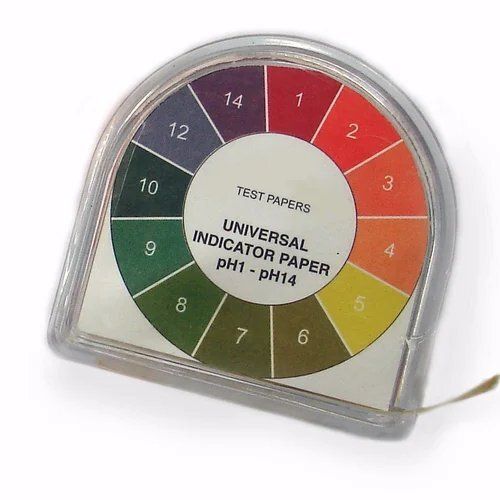PH सà¤à¤à¥à¤¤à¤
Price 200 आईएनआर/ टुकड़ा
PH सà¤à¤à¥à¤¤à¤ Specification
- उपयोग
- औद्योगिक
- प्रॉडक्ट टाइप
- पीएच संकेतक
- टाइप करें
- इलेक्ट्रोनिक
- थ्योरी
- क्षमता
- Usually in strips or liquid form; volume/package varies
- बाहरी सामग्री
- Plastic strip, paper, or vial
- आंतरिक सामग्री
- Absorbent paper or chemical reagent
- बाहरी आकार
- Standard strip: approx. 60 mm in length; can vary for bottles or boxes
- कंट्रोलर सिस्टम
- Manual comparison via color chart
- आर्द्रता सीमा
- Operates in ambient humidity; best stored dry
- तापमान सीमा
- Typically 0°C to 50°C; avoid extreme temperatures
PH सà¤à¤à¥à¤¤à¤ Trade Information
- Minimum Order Quantity
- 10 टुकड़ाs
- एफओबी पोर्ट
- VADODARA
- भुगतान की शर्तें
- ,
- आपूर्ति की क्षमता
- प्रति सप्ताह
- डिलीवरी का समय
- 7 दिन
- मुख्य निर्यात बाजार
- , , , , , , , ,
- मुख्य घरेलू बाज़ार
About PH सà¤à¤à¥à¤¤à¤
pH indicators are essential tools designed for accurate measurement and monitoring of the acidity or alkalinity of liquids. These devices come equipped with high-precision pH sensors or electrodes that detect the hydrogen ion concentration in a solution and convert this information into a readable output. The measurement is displayed digitally or analogically, often in pH units, and may include additional scales such as mV for more detailed analysis.
Featuring a user-friendly interface, pH indicators offer easy calibration and adjustment options to ensure precise readings. Advanced models may include functionalities such as automatic temperature compensation to account for temperature variations, data logging capabilities for tracking pH changes over time, and alarms that notify users of pH levels outside preset ranges. With their compact, durable design, pH indicators are suitable for a wide range of applications, including laboratory experiments, industrial processes, and environmental monitoring, providing reliable data for maintaining optimal conditions and ensuring process quality.
Precision and Reliability for All Applications
PH indicators deliver dependable accuracy between 0.2 to 0.5 pH units. With a standard measurement range of pH 1 to 14, these products are suitable for a broad spectrum of environments. Their robust manufacturing, in alignment with ISO and CE standards, guarantees conformity for industrial and laboratory applications, ensuring reliable results every time.
Easy-to-Use, Versatile Formats
Available as strips, paper, or solution, these indicators are simple to use and provide quick results. The manual color comparison system is intuitive and requires minimal training. The flexible packagingranging from packs of 100 strips to vials and bottlesserves both large-scale laboratories and small-scale users, optimizing for convenience and efficiency.
Storage and Longevity for Optimal Performance
Proper storage extends the shelf life of pH indicators to 12 years. It is recommended to keep them in a cool, dry location away from direct sunlight or moisture to preserve their sensitivity. Their packaging and robust materials ensure stability in ambient temperature and humidity, enhancing reliability throughout their lifespan.
FAQs of PH Indicators:
Q: How do I use pH indicator strips for accurate pH measurement?
A: To use pH indicator strips, immerse the strip into your sample solution for a few seconds, then immediately compare the resulting color change to the provided color chart. This manual matching process yields a pH reading with an accuracy between 0.2 and 0.5 units.Q: What is the typical shelf life of pH indicators, and how should they be stored?
A: pH indicators usually have a shelf life of 1 to 2 years if kept in a cool, dry place away from sunlight and moisture. Proper storage is essential to maintain their sensitivity and prevent degradation of the chemical reagent.Q: When should I choose strips, paper, or solution forms of pH indicators?
A: Strips and papers are ideal for quick, on-site testing due to their portability and ease of use, while liquid solutions are preferred in laboratory settings for higher precision and repetitive testing. Your choice depends on your specific application and accuracy requirements.Q: Where are these pH indicators commonly used?
A: These indicators are extensively used in industrial settings, laboratories, water treatment facilities, educational institutions, and quality control processes. Their compliance with industry standards makes them suitable for a variety of professional environments.Q: What distinguishes the color change interval of these pH indicators?
A: Each unit or half-unit pH shift is marked by a distinct color change, enabling clear, manual differentiation across the wide measurement range. This enhances both ease and accuracy in interpreting the results.Q: What are the primary benefits of using colorimetric or electrochemical pH indicators?
A: Colorimetric indicators provide a rapid, visual method for pH detection with simple manual comparison, while electrochemical types offer increased precision for electronic measurement. Both methods are reliable, efficient, and suitable for a range of industrial applications.

Price: Â
- 50
- 100
- 200
- 250
- 500
- 1000+
अधिक Products in पीएच संकेतक Category
ऑनलाइन Ph संकेतक
माप की इकाई : टुकड़ा/टुकड़े
प्रचालन विधि : Manual
उपयोग : प्रयोगशाला
प्रॉडक्ट टाइप : ऑनलाइन पीएच संकेतक
मूल्य या मूल्य सीमा : आईएनआर
वज़न : 200 जी ग्राम (g)
 जांच भेजें
जांच भेजें जांच भेजें
जांच भेजें

